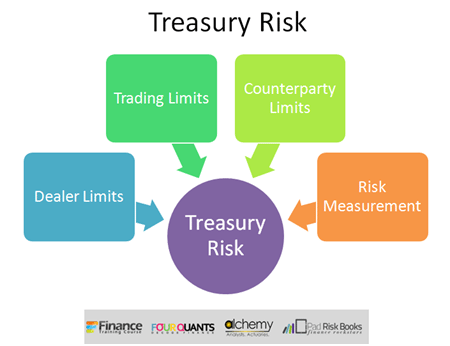Treasury Risk Training. Limits. Capital. Risk.
As a Treasury and investment management user, Treasury risk is one of the most frustrating challenges one faces on a daily basis.
As treasurers and portfolio managers we are forced to rely on historical data using questionable models that remain stable as long as markets behave but collapse and break down the minute panic creeps in. If this wasn’t bad enough we are restricted by the same models on a daily basis on the business side as we try and explore opportunities for price discovery and risk arbitrage. Sometime risk managers responsible for running risk, simply don’t get the relationship between risk and management. And it doesn’t help that good, market based Treasury Risk Training is hard to find.
The Treasury Risk Training directory attempts to fill this gap. We have shared our most popular posts dealing with treasury risk management. The list essentially focuses on measurable components risk managers have to deal with on a daily basis. Risk. Limits. Capital Allocation.
Figure 1 Treasury Risk Training Course – Core Themes
Limit Management – Introductory topics
- Dealer limits covering daily, weekly and monthly trade and position limits
- Trading limits covering stop loss, sector, segment, tenor & concentration in positions
- Counterparty limits covering pre-settlement risk and concentration of risk exposure
- Risk Measurements tools used for allocation of capital across trades and exposures
Treasury Risk Training – Core Themes
- Introduction to Treasury Operations
- Value at Risk Training resource
- Understanding Risk Exposures and Target Accounts
- Understanding Risk Exposure and Counterparty default
- The beginners guide to correlation
Treasury Risk Training – Setting Treasury Risk Limits
- Treasury Risk Limits-Counterparty Limits, Pre-settlement Risk (PSR) and Trading Limits
- Setting Treasury Risk Limits: Defining Risk Appetite, control limits and limit breaches
- Treasury Risk Limits: Working with Stop Loss Limits
- Setting Treasury Risk Limits: Worst Case Loss versus Most likely loss
- Setting Treasury Risk Limits: Value at Risk and Regulatory Approach Limits
Additional resources
- Treasury Middle Office Regulatory Audit & Review – Basel II Supervisory Review Criteria
- Sample Exam – Treasury Risk Training Course – Solved solution for Final Exam
- War on Greeks – Option Price Sensitivities & Delta Hedging
- Potential Future Exposure Estimation for an Interest Rate Swap.
- Expected and Unexpected Loss Calculation.
- The Investment Banking Interview Guide to the LIBOR scandal.


Comments are closed.